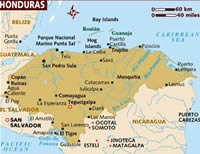| Home > Honduras |
HONDURAS:
Country Profile of Honduras
Honduras was home to several important indigenous cultures, one of them the Maya. Much of the country was conquered by Spain who introduced its predominant language and many of its customs in the sixteenth century. In 1821 it became independent and has been a republic since the end of Spanish rule.
Its size is just over 112,000 km² with an estimated population of almost eight million. Its northern portions are part of the Western Caribbean Zone. Honduras is notable for its production of minerals, tropical fruit, and recently for exportation of clothing for the international market.
|
☻Capital: - Tegucigalpa ☻Area: - Total: 112,492 sq km (43,433 sq miles) ☻Independence: - 1821 independence from Spain but remained under the guard of the Mexican Empire -1838 became an independent republic
|
☻Official languages: - Spanish, Quechua, Aymara ☻Population: - July 2005 census: 27,968,000 (41st) - 2005 census: 27,219,266 - Density: 22/kmē (183rd) 57/sq mi |
Geography of Honduras:

Honduras is the second largest republic in Central America. It has 735km of Caribbean coast to the north, running from the mouth of the Rio Motagua in the west, to the mouth of the Rio Coco in the east. The majority of the southern border meets with Nicaragua; however, the far south western border opens to the Pacific Ocean for a distance of 153 km at the Golfo de Fonseca. The western boundary is with El Salvador (stretching for 342km) and Guatemala (stretching for 256km). In addition, Honduras controls a number of small Caribbean islands as its offshore territories.
Honduras suffers from extensive deforestation due to the expansion of urbanization and population. Without adequate and lawful control this has resulted in soil erosion and deterioration of the land and, in addition, due to non-regulated mineral mining natural resources have been depleting. Such activities have resulted in the first signs of pollution of Lago de Yojoa, which is Honduras´s principal source of fresh water, as well as a number of rivers.
A National Planning Workshop was organized in 2007 to fight these alarming issues. More than 80 environmental agencies gathered together at the capital to set up an action plan to challenge the current problems. As a result of the conference, a ’10 point action plan’ was set up in December 2008, and put into practice in February 2009. With government assistance the country now has a specific course of action with a strong support system in place.
Education in Honduras:
 It was only in the 50´s of the last decade that school became accessible to everyone. Before the reforms of 1957, education was the exclusive privilege of the upper class, who could afford to send their children to private institutions. It was only when the government of 1957-63 introduced a national public education system and began a school construction program that education became accessible to the general population.
It was only in the 50´s of the last decade that school became accessible to everyone. Before the reforms of 1957, education was the exclusive privilege of the upper class, who could afford to send their children to private institutions. It was only when the government of 1957-63 introduced a national public education system and began a school construction program that education became accessible to the general population. Nowadays about 83.6% of the population of the country is literate. The net primary enrollment rate was 94% in 2004, while in 2007 the primary school completion rate was reported to be 40%.
What is very typical about Honduras is that it has bilingual (Spanish and English) and even trilingual (Spanish, English and German) schools and universities.
Health in Honduras:
Politics in Honduras
 Honduras has five key political parties:
Honduras has five key political parties:- National Party (Partido Nacional de Honduras: PNH)
- Liberal Party (Partido Liberal de Honduras: PLH)
- Social Democrats (Partido Innovación y Unidad-Social Demócrata: PINU-SD)
- Social Christians (Partido Demócrata-Cristiano de Honduras: DCH)
- Democratic Unification (Partido Unificación Democrática: UD).
PNH and PLH have ruled the country for decades. In the last years, Honduras has had six Liberal presidents: Roberto Suazo Córdova, José Azcona del Hoyo, Carlos Roberto Reina, Carlos Roberto Flores, Manuel Zelaya and Roberto Micheletti, and three Nationalists: Rafael Leonardo Callejas Romero, Ricardo Maduro and Porfirio Lobo Sosa.
The Honduran military has been a powerful force in domestic politics. A military coup was mounted against the democratically elected president Ramón Villeda Morales in 1963. This event started a string of Military Governments which held almost uninterrupted power until 1981 when Suazo Córdova (LPH) was elected.
Government ministries are often incapable of carrying out their mandate due to budgetary constraints. It has been said that 94% of the department budget was spent on bureaucracy and only 6% went to support activities and organizations covered by the mandate.
Amidst the waning of civil conflict in the region in the early 1990s, Honduras and the other Central American states turned their efforts to regional integration, particularly economic integration. In 1990 the Central American presidents signed a Central American Economic Action Plan (Plan de Acción Económica de Centroamérica-- Paeca), which included economic integration commitments and guidelines. In 1993 they established a regional integration governing body, the Central American Integration System (Sistema de Integración Centroamericana--Sica).
As a first step toward political integration, the Central American Parliament (Parlamento Centroamericano--Parlacen) was inaugurated in 1991; however, as of 1993 only Honduras, Guatemala, and El Salvador--the so-called northern triangle states--had elected representatives to that body. In September 1992, Honduras's long-time border conflict with El Salvador was resolved when the International Court of Justice (ICJ) awarded Honduras approximately two-thirds of the disputed territory. Both nations agreed to accept the ruling, which was viewed by many as a victory for Honduras.